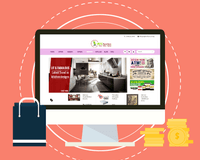Designing a home gym is a great way to ensure you stay committed to your fitness goals while enjoying the convenience and privacy of working out at home. Here’s a comprehensive guide to help you design the perfect home gym:
- Determine Your Fitness Goals
Before setting up your home gym, it's essential to define your fitness goals. Are you focusing on weightlifting, cardio, yoga, or a combination of activities? Understanding your objectives will help you choose the right equipment and design the layout effectively.
- Choose the Right Space
Select a space in your home that is well-ventilated, spacious, and free from distractions. Common options include a spare room, basement, garage, or even a section of your living room. Ensure there is enough room to move freely and safely.
- Plan Your Layout
Designing the layout is crucial for maximizing space and efficiency. Consider the following zones for different activities:
- Cardio Zone: For equipment like treadmills, stationary bikes, or ellipticals.
- Strength Training Zone: For weight loss journey, resistance bands, and strength machines.
- Flexibility and Recovery Zone: For yoga mats, foam rollers, and stretching areas.
- Storage Zone: For storing smaller equipment, towels, and other accessories.
- Invest in Essential Equipment
Based on your fitness goals, invest in equipment that suits your needs:
- Cardio Machines: Treadmills, stationary bikes, rowing machines, or ellipticals.
- Strength Training: Dumbbells, barbells, weight plates, kettlebells, resistance bands, and a weight bench.
- Flexibility and Recovery: Yoga mats, stability balls, foam rollers, and resistance bands.
- Multifunctional Equipment: Adjustable dumbbells, a power rack, and a cable machine can save space and provide versatility.
- Flooring
Choose appropriate flooring to protect your equipment and floors while providing a safe workout environment. Rubber mats, foam tiles, or carpet tiles are popular choices that offer good shock absorption and are easy to clean.
- Lighting and Ventilation
Good lighting and ventilation are essential for a comfortable workout environment. Use bright, natural light if possible, and supplement with artificial lighting. Ensure proper ventilation with windows, fans, or an air conditioning unit to maintain a cool and fresh atmosphere.
- Mirrors
Installing mirrors can help with form and technique while creating an illusion of a larger space. They also make the room feel more like a professional gym.
- Entertainment and Motivation
Incorporate elements that keep you motivated, such as a sound system, TV, or motivational posters. Playing your favorite music or following workout videos can enhance your exercise experience.
- Storage Solutions
Keep your gym organized with storage solutions like shelves, hooks, and cabinets. This will ensure that your equipment is easily accessible and your workout space remains clutter-free.
- Safety Considerations
Safety should be a priority in your home gym design:
- Ensure there is enough space around each piece of equipment.
- Use non-slip mats and secure equipment to prevent accidents.
- Keep a first aid kit nearby for emergencies.
- Personal Touches
Add personal touches to make the space inviting and motivating. This could include plants, artwork, or a color scheme that you find energizing.
- Budgeting
Plan your budget carefully. Start with essential equipment and gradually add more as needed. Look for second-hand equipment or sales to save money without compromising on quality.
Conclusion
Designing a home gym tailored to your fitness goals can significantly enhance your workout routine. By considering your needs, planning the layout, investing in the right equipment, and ensuring safety, you can create an efficient and enjoyable workout space in your home. Start small, stay consistent, and enjoy the convenience and benefits of having a personal gym just a few steps away.



























